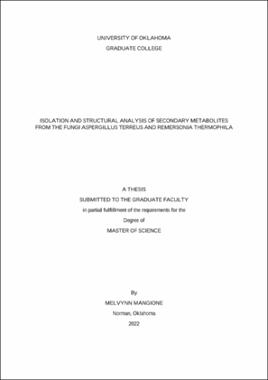| dc.contributor.advisor | Cichewicz, Robert | |
| dc.contributor.author | Mangione, Melvynn | |
| dc.date.accessioned | 2022-05-09T16:37:23Z | |
| dc.date.available | 2022-05-09T16:37:23Z | |
| dc.date.issued | 2022-05-13 | |
| dc.identifier.uri | https://hdl.handle.net/11244/335635 | |
| dc.description.abstract | Aspergillus terreus has shown to inhibit M. genitalium whereas Remersonia thermophila has shown to exhibit antitrichomonal activity. The compounds that were responsible for activity in their respective assays were rapidly and efficiently isolated with a bioassay-guided fractionation procedure. Following this isolation step, the active compounds could be structurally characterized. Therefore, the goal of this research project was initially to purify and identify the active compounds present in Aspergillus terreus and Remersonia thermophila.
Through the development of efficient analytical methods for the fractionation and purification of the two fungi produced natural products, several active compounds were isolated. Within the time frame of this degree, characterization of the active molecules was not possible due to insufficient material. However, the activity of these compounds showed promise and further research into these compounds is required. The methods that were developed to isolate the active compounds can serve as a blueprint for a more rapid and straightforward isolation of these molecules which could lead to their characterization thereafter.
To successfully complete this thesis, metabolites were studied regardless of their activity. Hence, compounds 31C and 52C were explored given their more generous quantities. The structural characterization of these compounds was followed through to completion. These two compounds were not described in the literature, and it was soon discovered that these compounds presented a novel chemical scaffold. Therefore, extensive characterization through an array of spectroscopic techniques and mass data was required to elucidate the structures of these molecules. Their absolute configurations were established through ECD and VCD calculations. The new chemistry that was discovered will hopefully guide the discovery and synthesis of new drugs and help break through drug discovery plateaus. | en_US |
| dc.language | en_US | en_US |
| dc.rights | Attribution-NonCommercial-NoDerivatives 4.0 International | * |
| dc.rights.uri | https://creativecommons.org/licenses/by-nc-nd/4.0/ | * |
| dc.subject | Remersonia thermophila | en_US |
| dc.subject | Aspergillus terreus | en_US |
| dc.subject | bioassay-guided fractionation | en_US |
| dc.subject | structural analysis | en_US |
| dc.title | Isolation and structural analysis of secondary metabolites from the fungi Aspergillus terreus and Remersonia thermophila | en_US |
| dc.contributor.committeeMember | Wu, Si | |
| dc.contributor.committeeMember | Bourne, Christina | |
| dc.date.manuscript | 2022-05 | |
| dc.thesis.degree | Master of Science | en_US |
| ou.group | Dodge Family College of Arts and Sciences::Department of Chemistry and Biochemistry | en_US |
| shareok.orcid | https://orcid.org/ 0000-0001-6420-0165 | en_US |
| shareok.nativefileaccess | restricted | en_US |

